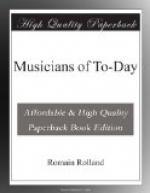[Footnote 65: In 1830, old Rouget de Lisle called Berlioz, “a volcano in eruption” (Memoires, I, 158).]
[Footnote 66: M. Camille Saint-Saens wrote in his Portraits et Souvenirs, 1900: “Whoever reads Berlioz’s scores before hearing them played can have no real idea of their effect. The instruments appear to be arranged in defiance of all common sense; and it would seem, to use professional slang, that cela ne dut pas sonner, but cela sonne wonderfully. If we find here and there obscurities of style, they do not appear in the orchestra; light streams into it and plays there as in the facets of a diamond.”]
[Footnote 67: See the excellent essay of H. Lavoix, in his Histoire de l’Instrumentation. It should be noticed that Berlioz’s observations in his Traite d’instrumentation et d’orchestration modernes (1844) have not been lost upon Richard Strauss, who has just published a German edition of the work, and some of whose most famous orchestral effects are realisations of Berlioz’s ideas.]
Think of the effect that such works must have produced at that period. Berlioz was the first to be astonished when he heard them for the first time. At the Ouverture des Francs-Juges he wept and tore his hair, and fell sobbing on the kettledrums. At the performance of his Tuba mirum, in Berlin, he nearly fainted. The composer who most nearly approached him was Weber, and, as we have already seen, Berlioz only knew him late in life. But how much less rich and complex is Weber’s music, in spite of its nervous brilliance and dreaming poetry. Above all, Weber is much more mundane and more of a classicist; he lacks Berlioz’s revolutionary passion and plebeian force; he is less expressive and less grand.
How did Berlioz come to have this genius for orchestration almost from the very first? He himself says that his two masters at the Conservatoire taught him nothing in point of instrumentation:—
“Lesueur had only very limited ideas about the art. Reicha knew the particular resources of most of the wind instruments; but I think that he had not very advanced ideas on the subject of grouping them.”
Berlioz taught himself. He used to read the score of an opera while it was being performed.
“It was thus,” he says,[68] “that I began to get familiar with the use of the orchestra, and to know its expression and timbre, as well as the range and mechanism of most of the instruments. By carefully comparing the effect produced with the means used to produce it, I learned the hidden bond which unites musical expression to the special art of instrumentation; but no one put me in the way of this. The study of the methods of the three modern masters, Beethoven, Weber, and Spontini, the impartial examination of the traditions of instrumentation and of little-used forms and combinations, conversations with virtuosi,




